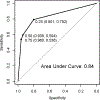Intensive longitudinal assessment following index trauma to predict development of PTSD using machine learning
- PMID: 38723405
- PMCID: PMC11215748
- DOI: 10.1016/j.janxdis.2024.102876
Intensive longitudinal assessment following index trauma to predict development of PTSD using machine learning
Abstract
There are significant challenges to identifying which individuals require intervention following exposure to trauma, and a need for strategies to identify and provide individuals at risk for developing PTSD with timely interventions. The present study seeks to identify a minimal set of trauma-related symptoms, assessed during the weeks following traumatic exposure, that can accurately predict PTSD. Participants were 2185 adults (Mean age=36.4 years; 64% women; 50% Black) presenting for emergency care following traumatic exposure. Participants received a 'flash survey' with 6-8 varying symptoms (from a pool of 26 trauma symptoms) several times per week for eight weeks following the trauma exposure (each symptom assessed ∼6 times). Features (mean, sd, last, worst, peak-end scores) from the repeatedly assessed symptoms were included as candidate variables in a CART machine learning analysis to develop a pragmatic predictive algorithm. PTSD (PCL-5 ≥38) was present for 669 (31%) participants at the 8-week follow-up. A classification tree with three splits, based on mean scores of nervousness, rehashing, and fatigue, predicted PTSD with an Area Under the Curve of 0.836. Findings suggest feasibility for a 3-item assessment protocol, delivered once per week, following traumatic exposure to assess and potentially facilitate follow-up care for those at risk.
Keywords: Emergency services; Machine learning; Mobile assessment; Posttraumatic stress disorder; Trauma.
Copyright © 2024 Elsevier Ltd. All rights reserved.
Conflict of interest statement
Declaration of Competing Interest Dr. Neylan has received research support from NIH, VA, and Rainwater Charitable Foundation, and consulting income from Jazz Pharmaceuticals. In the last three years Dr. Clifford has received research funding from the NSF, NIH and LifeBell AI, and unrestricted donations from AliveCor Inc, Amazon Research, the Center for Discovery, the Gates Foundation, Google, the Gordon and Betty Moore Foundation, MathWorks, Microsoft Research, Nextsense Inc, One Mind Foundation, and the Rett Research Foundation. Dr. Clifford has financial interest in AliveCor Inc and Nextsense Inc. He also is the CTO of MindChild Medical with significant stock. These relationships are unconnected to the current work. Dr. Germine receives funding from the National Institute of Mental Health (R01 MH121617) and is on the board of the Many Brains Project. Her family also has equity in Intelerad Medical Systems, Inc. Dr. Rauch reported serving as secretary of the Society of Biological Psychiatry; serving as a board member of Community Psychiatry and Mindpath Health; serving as a board member of National Association of Behavioral Healthcare; serving as secretary and a board member for the Anxiety and Depression Association of America; serving as a board member of the National Network of Depression Centers; receiving royalties from Oxford University Press, American Psychiatric Publishing Inc, and Springer Publishing; and receiving personal fees from the Society of Biological Psychiatry, Community Psychiatry and Mindpath Health, and National Association of Behavioral Healthcare outside the submitted work. Dr. Jones has no competing interests related to this work, though he has been an investigator on studies funded by AstraZeneca, Vapotherm, Abbott, and Ophirex. Dr. Joormann receives consulting payments from Janssen Pharmaceuticals. Dr. Harte has no competing interest related to this work, though in the last three years he has received research funding from Aptinyx and Arbor Medical Innovations, and consulting payments from Aptinyx. Dr. Koenen’s research has been supported by the Robert Wood Johnson Foundation, the Kaiser Family Foundation, the Harvard Center on the Developing Child, Stanley Center for Psychiatric Research at the Broad Institute of MIT and Harvard, the National Institutes of Health, One Mind, Anonymous Philanthropy, LLC, and Cohen Veterans Bioscience. She has been a paid consultant for the US Department of Justice and Covington Burling, LLP over the last three years. She has been a paid external reviewer for the Chan Zuckerberg Foundation, the University of Cape Town, and Capita Ireland. She has had paid speaking engagements in the last three years with the American Psychological Association, European Central Bank. Sigmund Freud University – Milan, Cambridge Health Alliance, and Coverys. She receives royalties from Guilford Press and Oxford University Press. Dr. McLean has served as a consultant for Walter Reed Army Institute for Research, Arbor Medical Innovations, and BioXcel Therapeutics, Inc.
Figures



References
-
- American Psychiatric Association. (2013). Diagnostic and statistical manual of mental disorders: DSM-5. American Psychiatric Association.
-
- Bovin MJ, Marx BP, Weathers FW, Gallagher MW, Rodriguez P, Schnurr PP, & Keane TM (2016). Psychometric properties of the PTSD checklist for diagnostic and statistical manual of mental disorders–fifth edition (PCL-5) in veterans. Psychological assessment, 28(11), 1379–1391. 10.1037/pas0000254 - DOI - PubMed
MeSH terms
Grants and funding
LinkOut - more resources
Full Text Sources
Medical

